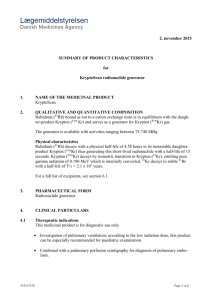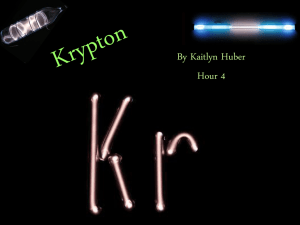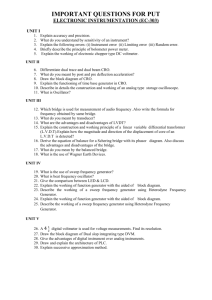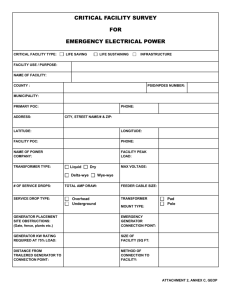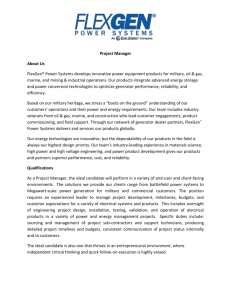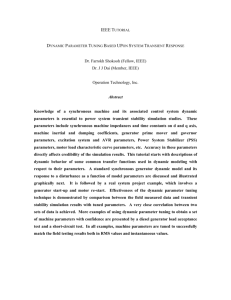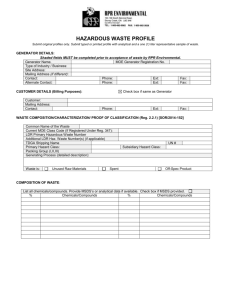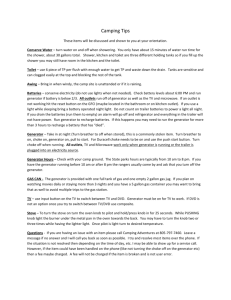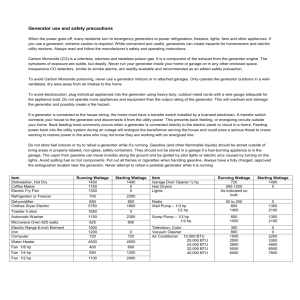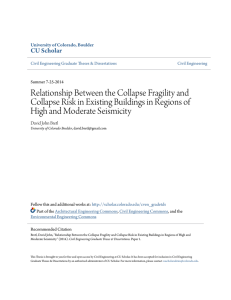Physical characteristics
advertisement
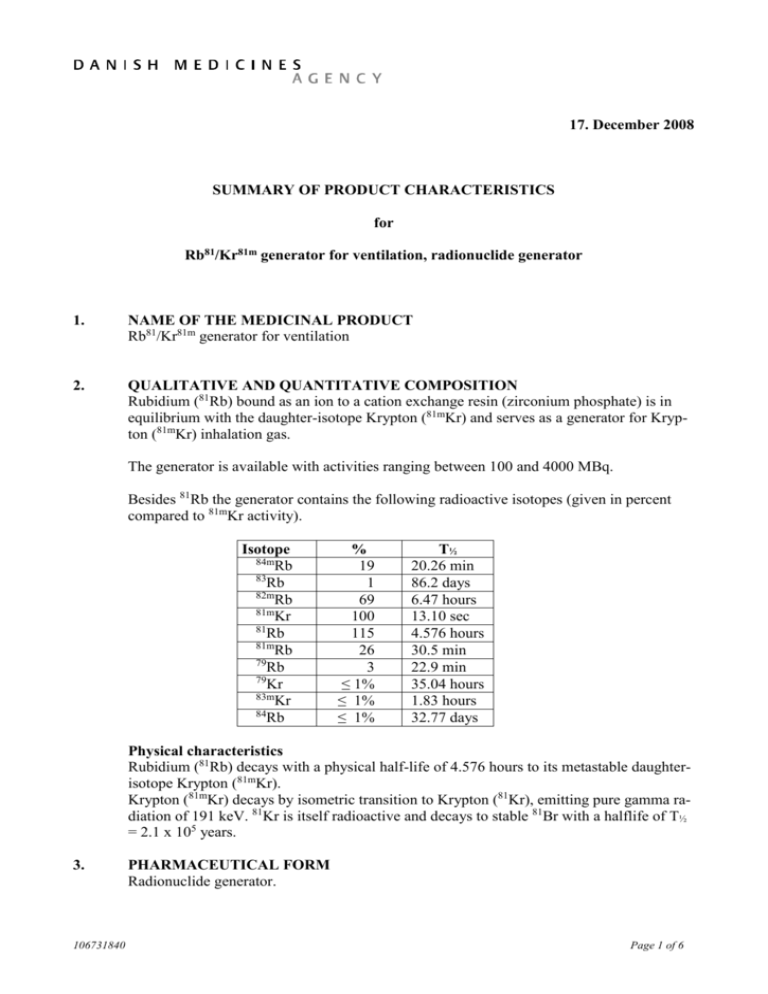
17. December 2008 SUMMARY OF PRODUCT CHARACTERISTICS for Rb81/Kr81m generator for ventilation, radionuclide generator 1. NAME OF THE MEDICINAL PRODUCT Rb81/Kr81m generator for ventilation 2. QUALITATIVE AND QUANTITATIVE COMPOSITION Rubidium (81Rb) bound as an ion to a cation exchange resin (zirconium phosphate) is in equilibrium with the daughter-isotope Krypton (81mKr) and serves as a generator for Krypton (81mKr) inhalation gas. The generator is available with activities ranging between 100 and 4000 MBq. Besides 81Rb the generator contains the following radioactive isotopes (given in percent compared to 81mKr activity). Isotope 84m Rb 83 Rb 82m Rb 81m Kr 81 Rb 81m Rb 79 Rb 79 Kr 83m Kr 84 Rb % 19 1 69 100 115 26 3 ≤ 1% ≤ 1% ≤ 1% T½ 20.26 min 86.2 days 6.47 hours 13.10 sec 4.576 hours 30.5 min 22.9 min 35.04 hours 1.83 hours 32.77 days Physical characteristics Rubidium (81Rb) decays with a physical half-life of 4.576 hours to its metastable daughterisotope Krypton (81mKr). Krypton (81mKr) decays by isometric transition to Krypton (81Kr), emitting pure gamma radiation of 191 keV. 81Kr is itself radioactive and decays to stable 81Br with a halflife of T½ = 2.1 x 105 years. 3. 106731840 PHARMACEUTICAL FORM Radionuclide generator. Page 1 of 6 4. CLINICAL PARTICULARS 4.1 Therapeutic indications This medicinal product is for diagnostic use only. Investigation of pulmonary ventilation; according to the low radiation dose, this product can be especially recommended for paediatric examination. Combined with a pulmonary perfusion scintigraphy for diagnosis of pulmonary embolism. Pulmonary ventilation (81mKr) / perfusion (99Tc-macroaggregation) studies are possible because of the different spectrometric windows of 81mKr and 99mTc. 4.2 Posology and method of administration Krypton images are acquired during the continuous inhalation of the short-lived and otherwise inert radioactive gas, Krypton (81mKr). The gas is eluted from the generator with humidified air and administered to the patient through a face mask or airway. In general, adequate imaging is achieved when 200000-350000 counts are accumulated per gamma camera image. This corresponds to approx. 18 MBq/kg body weight. Most investigations require 4 to 6 images. The activities for children may be calculated according to the following equation: Activity-child (MBq) = Activity-adult (MBq) x body weight (kg) 70 (kg) Continuous inhalation is stopped upon acquisition of approx. 300000 counts per gamma camera image. 4.3 Contraindications Hypersensitivity to the active substance or to any of the excipients. 4.4 Special warnings and precautions for use There are no specific warnings or precautions for use for this radiopharmaceutical product. 4.5 Interaction with other medicinal products and other forms of interaction Diazepam in sedative doses and general anaesthetic agents may affect the distribution of radioactive gases in the lung by slightly shifting the activity to the lung apex and reducing basal accumulation. 4.6 Pregnancy and lactation Pregnancy Only imperative investigations should be carried out during pregnancy, when the likely benefit exceeds the risk incurred by mother and foetus. Radionuclide procedures carried out on pregnant women also involve radiation doses to the foetus. When it is necessary to administer radioactive medicinal product to women of childbearing potential, information should always be sought about pregnancy. Any woman who has 106731840 Page 2 of 6 missed a period should be assumed to be pregnant until proven otherwise. Where uncertainty exists it is important that radiation exposure should be the minimum consistent with achieving the desired clinical information. Alternative techniques which do not involve ionising radiation should be considered. Lactation If it is necessary to administer krypton (81mKr) inhalation gas to a mother who is breastfeeding, the woman should not breastfeed until the investigation is over. If the woman also is administered with (99mTc), the period of time before which breastfeeding can recommence (due to accumulation of radioactivity in the breast milk) depends on the amount of (99mTc) given. 4.7 Effects on ability to drive and use machines No studies on the effects on the ability to drive and use machines have been performed. 4.8 Undesirable effects No adverse/undesirable effects have been reported for this agent. For each patient, exposure to ionising radiation must be justifiable on the basis of likely clinical benefit. The activity administered must be such that the resulting radiation dose is as low as reasonably achievable bearing in mind the need to obtain the intended diagnostic or therapeutic result. Exposure to ionising radiation is linked with cancer induction and a potential for development of hereditary defects. For diagnostic nuclear medicine investigations the current evidence suggests that these adverse effects will occur with negligible frequency because of the low radiation dose incurred. For diagnostic investigations using a nuclear medicine procedure the radiation dose delivered (EDE) is less than 20 mSv. Higher doses may be justified in some clinical circumstances. 4.9 Overdose In the unlikely event of radiation overdose caused by a prolonged period of krypton gas inhalation, patients need only be removed from the source of radiation to a fresh and uncontaminated atmosphere. 5. PHARMACOLOGICAL PROPERTIES 5.1 Pharmacodynamic properties ATC code: V 09 EX 01 - Diagnostic radiopharmaceuticals, respiratory system. Krypton is an inert gas that is not metabolised and in the concentrations applied Krypton (81mKr) inhalation gas shows no pharmacodynamic effects. 5.2 106731840 Pharmacokinetic properties Krypton (81mKr) inhalation gas is an inert gas with a short biological half-life. Due to its rapid decay the effective half-time of lung elimination is equal to the physical half-life of 13.10 seconds. Peripheral Krypton (81mKr) radioactivity is exhaled after the first passage. Page 3 of 6 5.3 Preclinical safety data No data available. 6. PHARMACEUTICAL PARTICULARS 6.1 List of excipients Zirconium phosphate Water, partly as hydrated water, absorbed on zirconium phosphate 6.2 Incompatibilities The generator must only be eluted with humidified air, never with water or other fluids. Flushing with high ionic strength solutions will remove a considerable part of the mothernuclide and radioactive impurities from the generator cartridge. 6.3 Shelf life 1 day. 8 hours after calibration. 6.4 Special precautions for storage Store below 25°C. Do not freeze. Use lead shielding. Storage should be in accordance with the national regulations for radioactive materials. The used generator cartridge should be handled as long-lived radioactive waste due to the content of long-lived rubidium radionuclides. 6.5 Nature and contents of container The generator material (zirconium phosphate) is encapsulated in a small acrylic tube and held in place between two Vyon, polythene (Ziegler type) filter discs. The resulting cartridge, following loading with radioactivity, is transported, used and returned in a sealed stainless steel tube (inner container). During transport the inner container, containing the cartridge, is attached to a lead plug. The inner container with attached lead plug is inserted in to a lead container, which is subsequently sealed in an aluminium can (outer container). 6.6 Special precautions for disposal and other handling This product should be stored and handled in accordance with national regulations concerning radioactive products. The used generator cartridge contains long-lived radionuclides and should be returned to the manufacturer for disposal using the outer container. 7. MARKETING AUTHORISATION HOLDER PET & Cyclotron Unit Dept. Of Clinical Physiology and Nuclear Medicine Rigshospitalet, section 3982 Blegdamsvej 9 DK-2100 Copenhagen 8. MARKETING AUTHORISATION NUMBER DK R 1179 106731840 Page 4 of 6 9. DATE OF FIRST AUTHORISATION 31. January 1995 10. DATE OF REVISION OF THE TEXT 17. December 2008 106731840 Page 5 of 6 11. DOSIMETRY Data from ICRP publication 53 (Vol.18; no 1-4, 1987) "Radiation dose to patients from radiopharmaceuticals", absorbed dose per unit activity administered (mGy/MBq) and ICRP 80 (Vol 28; no.3, 1998) Addendum 2 to ICRP 53. Organ Adrenals Bladder wall Bone surfaces Breast GI-tract: Stomach wall Small intest ULI wall LLI wall Adult 3.4E-06 6.8E-08 1.7E-06 4.6E-06 15 year 5.7E-06 7.6E-08 2.2E-06 4.6E-06 10 year 8.3E-06 2.0E-07 3.2E-06 8.9E-06 5 year 1.3E-05 4.7E-07 4.8E-06 1.3E-05 1 year 2.1E-05 1.2E-06 9.3E-06 1.8E-05 2.5E-06 2.7E-07 3.2E-07 1.4E-07 3.2E-06 4.7E-07 5.5E-07 1.5E-07 4.4E-06 8.6E-07 1.2E-06 3.0E-07 6.7E-06 1.6E-06 1.9E-06 8.0E-07 1.1E-05 3.4E-06 3.5E-06 2.0E-06 Kidneys Liver Lungs Ovaries Pancreas 1.2E-06 3.4E-06 2.1E-04 1.7E-07 3.5E-06 1.9E-06 4.8E-06 3.1E-04 1.7E-07 4.4E-06 2.9E-06 6.6E-06 4.4E-04 4.1E-07 6.4E-06 4.5E-06 9.5E-06 6.8E-04 8.0E-07 9.8E-06 8.4E-06 1.6E-05 1.3E-03 1.9E-06 1.8E-05 Red marrow Spleen Testes Thyroid Uterus 2.1E-06 3.1E-06 1.7E-08 1.2E-06 1.3E-07 3.3E-06 4.1E-06 2.3E-08 2.1E-06 1.8E-07 4.2E-06 6.0E-06 7.4E-08 3.7E-06 3.5E-07 5.3E-06 9.2E-06 1.3E-08 6.0E-06 7.2E-07 8.2E-06 1.6E-05 5.6E-07 1.1E-05 1.8E-06 Other tissue Effective dose equivalent (mSv/MBq) 1.8E-06 2.3E-06 3.2E-06 4.7E-06 8.5E-06 2.7E-05 4.0E-05 5.7E-05 8.8E-05 1.7E-04 For this product the effective dose equivalent resulting from an administered activity of 3000-9000 MBq, (range of actual exposure) expected activities in adults, is 0.08-0.24 mSv. 12. INSTRUCTIONS FOR PREPARATION OF RADIOPHARMACEUTICALS This product should be stored and handled in accordance with national regulations concerning radioactive products. The radioactive generator cartridge can only be used in a specific stationary generator arrangement provided by the manufacturer. The outer container (aluminium can) is removed from the transport container and placed behind a lead shield next to the stationary generator arrangement (previously supplied by the manufacturer). Detailed directions for these procedures are described in the package insert and must be followed. 106731840 Page 6 of 6
